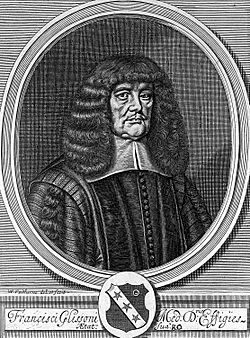Francis Glisson facts for kids
Quick facts for kids
Francis Glisson
|
|
|---|---|

Francis Glisson
|
|
| Born | 1597 |
| Died | 14 October 1677 |
| Nationality | British |
| Known for | Fibrous capsule of Glisson |
| Scientific career | |
| Fields | physician |
Francis Glisson (born in 1597 – died on 14 October 1677) was an important British physician, anatomist (someone who studies the body's structure), and writer on medical topics. He did very important work on the liver and wrote one of the first books about a bone disease called rickets. He also did a clever experiment that helped explain how muscles work.
Contents
Who Was Francis Glisson?
Francis Glisson was born in Bristol, England, in 1597. He grew up and studied in Rampisham, Dorset. Later, he went to Gonville and Caius College, Cambridge, which is part of the famous University of Cambridge.
He became a very respected doctor and was even a professor at Cambridge for 40 years! This important job was called the Regius Professor of Physic. Many medical terms still use his name today, like 'Glisson's capsule,' because of his important discoveries. He spent his later years living in Covent Garden and passed away in London.
His Big Discoveries
Understanding the Liver
One of Glisson's most famous contributions was his detailed study of the liver. He carefully looked at its structure and described a special covering around it. This covering is now known as the fibrous capsule of Glisson, named after him.
Studying Rickets
Glisson also wrote one of the first books about rickets. Rickets is a disease that affects children, making their bones soft and weak. His book helped other doctors understand and treat this condition better. This was a very early text focused on children's health.
The Muscle Experiment
He performed a smart experiment to understand how muscles contract. At the time, some people thought that muscles grew bigger by filling with air or fluid when they contracted. This was called the "balloonist theory."
Glisson put a muscle under water and made it contract. He noticed that the water level did not rise. This showed that no extra air or fluid was entering the muscle when it contracted. His experiment helped prove that the "balloonist theory" was wrong and helped scientists better understand how muscles really work.
See also


